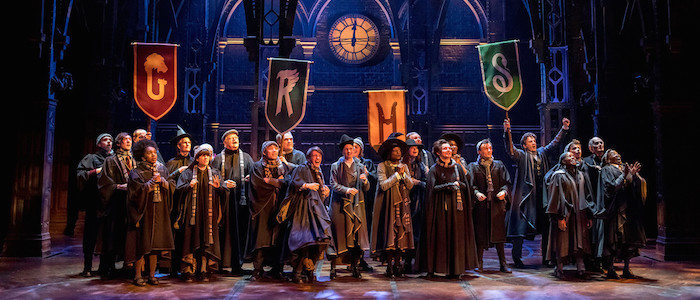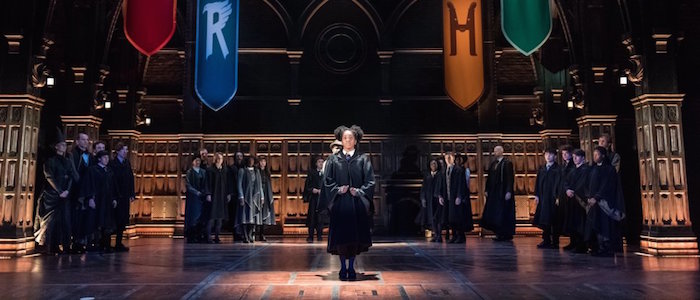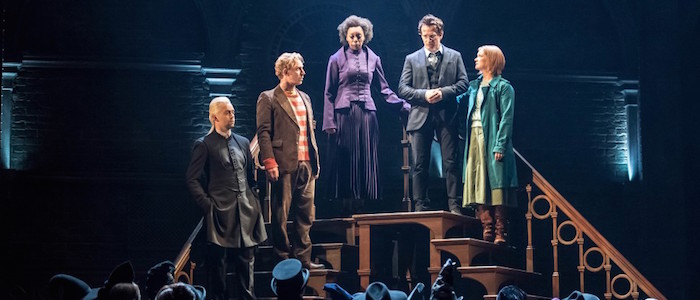Broadway’s two-part Harry Potter and the Cursed Child production is a fascinating beast. It brings with it most of its West End cast, acting as direct sequel to the books yet trading on the iconography of the film series, all while making its own unique mark on Harry Potter canon. Picking up from the originals’ “Seventeen Years Later” epilogue, it follows a new generation of characters – best friends Albus Potter and Scorpius Malfoy, sons of bitter rivals Harry and Draco – across four years of their schooling in a matter of minutes, before diving back into time itself.
Time is central to The Cursed Child, both as a fictional construct as well as a force of nostalgia. The play’s relationship to an audience that grew up with these characters is paramount. However, the only “Easter eggs” it trades in are those that, through their exploration, lead to a more complex, more complete understanding of the characters as they enter their middle age. Each adult character – Ron, Hermione, Ginny, but especially Harry and Draco – carries the weight of their past adventures, both the guilt and the glory, in ways that impact their children.
The Story So Far
What is The Cursed Child about, exactly? Well, per the barely contextualized spoilers published in 2016 (spoilers from here on out, of course), it’s about Albus and Scorpius time-travelling to events familiar to the audience, amidst a plot involving Voldemort’s supposed secret child. Which sounds suitably fan fiction-esque, as many detractors would go on to note based on the spoilers alone. Though the play’s status as “fan fiction” – an aesthetic term more than a literal one, owing to J.K. Rowling’s involvement – isn’t far off the mark. Albus and Scorpius do act as self-insert characters, in a sense, but this works to the play’s advantage. They’re geeky, angsty outcasts exploring the stories of their childhood, events that unfolded during original characters’ lives and defined their own in the process. Two lonely kids trying to live up to their predecessors by entering their decades-old narratives and influencing them from the margins, hoping for a different outcome.
That’s what The Cursed Child is “about,” most certainly, but what it’s about, at its core, is the effect of time on people and relationships.
The two-part play is a powerful father-son story in its written form. The focus of its words – its published manuscript is certainly wordy – is the complicated dynamic between Harry and his younger son Albus, a child he inadvertently overshadows with his fame. Harry, “The Boy Who Lived,” is now the boy who defeated Voldemort twice. A brave Gryffindor whose oldest child, the boisterous James, follows easily in his footsteps. Albus however, the quieter son with no affinity for sport, finds himself sorted into Slytherin, a House formerly marked by ambition but now defined (both in-world and by many a fan) by its relationship to evil. Fellow Slytherin Scorpius finds himself similarly overshadowed, albeit for different reasons. His father Draco once aligned himself with Voldemort, a decision that keeps both father and son on the social margins, but rumor has it Scorpius may be the secret heir of Voldemort himself. Whatever the case, Scorpius’ peers make him pay for the sins of each of his fathers, both real and presumed. He grows up entirely isolated – but for Albus’ friendship, that is.
Witchcraft and Stagecraft
The relationships between these sons and fathers is strained to say the least, but the lens through which they’re explored is set up before the play even begins. Upon entering New York’s Lyric Theater, one is greeted by a stage that expands deeper than usual – the production reportedly removed 400 seats from the auditorium – a space illuminated by a solitary source. From the rear end of the arched façade, a clock-face beams down on the stage like a spotlight, as if bringing with it sunlight, and promise, from the other side of a window. Flanking this clock are rows of pillars on either side. They move inward to reveal branches whenever the setting shifts to the Forbidden Forest, the location from where most of the characters travel through time. These pillars too are adorned by clocks at their apex with each row forming an arch in turn, connecting the clock faces on stage left to those on stage right, as if drawing a line from cause to effect.
The design is lavish. Its execution, precise. While a handful of scenes oscillate between rushed and stretched, every movement, every interlude and every detail has purpose. Many of the conversations take place between characters atop a pair of stairs, not unlike the moving staircases of Hogwarts castle, as fans may recall. Each flight is wheeled in and rotated, musically, until the characters come face to face, like a second and minute hand meeting momentarily.
The play is rife with sleight of hand, the kind of magical stage production that’ an utter delight even for those who disliked the published story. The opening at King’s Cross station sees the Potters and Granger-Weasleys charge through the famous magical platform (Nine and Three Quarters), switching from civilian casuals to magical robes within a momentary flash. Actors often transform and transfigure into one another by inhabiting the same cloak, twisting and contorting in partial darkness, often hilariously and to much applause. Numerous wand duels feature hidden stage-hands making objects float, a marvel to behold, but the one trick that seems to garner the most awestruck response is when time runs in reverse.
The Passage of Time
The characters use a pocket-sized Time Turner – first seen in Harry Potter and the Prisoner of Azkaban – to travel into the past. Whenever the characters visit these events (seen in previous books and films), the stage darkens but for their silhouettes and the outlines of the clock-faced arches. The clocks run backwards, scored by recent dialogue fresh in the audience’s memory until suddenly, a wave-like effect envelops the backdrop, seemingly moving wood and metal like wind caressing a curtain.
It’s disorienting at first, in an awe-inspiring way. It’s the kind of trick you don’t normally see with the naked eye, but the second or perhaps third time it occurs, the cause of the ripple becomes clearer. Light hits the furthest point of the stage before moving (concentrically, turning the stage into a clock-face of its own) toward the front, along the meticulously crafted backdrop that now reveals its hidden purpose. The result is an impossible, enveloping ripple. Something we ought not to see, as if the fabric of space and time have been infringed upon. It happens five, maybe six times in total, but it never loses its charm.
While the play features no songs, it beats with the distinct vibrancy of a musical. Scene transitions, whether traversing hundreds of miles or perhaps years in the very same spot, feature energetic, choreographed ensembles drawing one into the setting. A semester of lessons on how to conjure spells is turned into dance of light, with kids being led by their illuminated wands. Students populate the background of every scene at the school – that is, until the conversations in focus become private – and the Hogwarts express is a seated row of excited teens being rotated, again, like a clock. The stage never moves, but for the mechanical tricks and contraptions at its center, but we constantly move within it as time ticks on.
These constant flourishes are reminders of the story’s foundation, one rooted in the passage of time. While the seven books (and eight movies) that defined the last decade are an important prerequisite, newcomers are filled in on just enough of the backstory through Harry’s returning dreams. Moments from his past, enveloped in fog, articulated the origins of Harry Potter. The lies about his parents’ deaths. The looming threat of Lord Voldemort. And of course, the exciting promise of magic.
Continue Reading Harry Potter and the Cursed Child >>
The post A Journey Through Time: Examining ‘Harry Potter and the Cursed Child’ on Broadway appeared first on /Film.
from /Film https://ift.tt/2smkGax




No comments:
Post a Comment